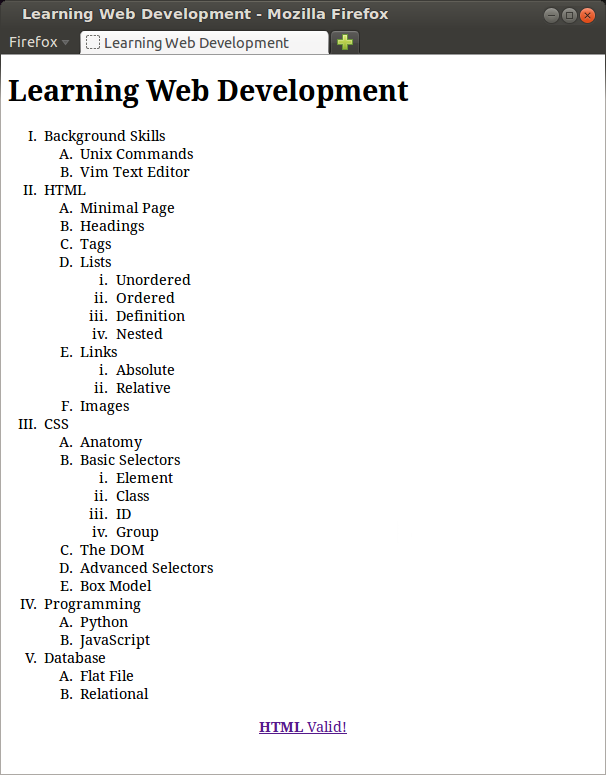Unordered Lists
- This is a list item or
li. - It is in an unordered list or
ul. - The list is opened with a
<ul>tag. - Each item is between
<li></li>tags. - The list is closed with a
</ul>tag.
Here is how the list parts should look together in a list of fruits:
<ul> <li>apples</li> <li>bananas</li> <li>cherries</li> <li>grapes</li> </ul>
When rendered it looks like this:
- apples
- bananas
- cherries
- grapes
Note:
white space
more than a single character is ignored by browsers when rendering HTML source
(except in <pre></pre> elements), but formating
is important to people who create and maintain HTML documents. So keep
your HTML source clean with indentation and white space to make it easy to
read.
Ordered Lists
- Ordered lists are used for enumerated items.
- This is a ordered list item which starts with
<ol> - Each list item is still a
<li>. - Close it with a
</ol>
Ordered lists come in five types, which enumerate the list with:
<ol type=: decimal numbers (1, 2, 3, ...), the default type.1
>
<ol type=: lower case letters (a, b, c, ...).a
>
<ol type=: upper case letters (A, B, C, ...).A
>
<ol type=: lower case roman numbers (i, ii, iii, iv, ...).i
>
<ol type=: upper case roman numbers (I, II, III, IV, ...).I
>
Add the appropiate type attribute to the inside the open
ol tag to get the enumeration type you want.
Let's look at our list of fruits again enumerated with upper case Roman numbers:
<ol type="I"> <li>apples</li> <li>bananas</li> <li>cherries</li> <li>grapes</li> </ol>
When rendered it looks like this:
- apples
- bananas
- cherries
- grapes
Description Lists
This is used for lists of terms and their descriptions.
- HTML
- Hyper-text Markup Language
- WWW
- World Wide Web
- W3C
- World Wide Web Consortium
- dl
- description list
- dt
- description term
- dd
- description details
The source code looks like this:
<dl> <dt>HTML</dt><dd>Hyper-text Markup Language</dd> <dt>WWW</dt><dd>World Wide Web</dd> <dt>W3C</dt><dd>World Wide Web Consortium</dd> <dt>dl</dt><dd>description list</dd> <dt>dt</dt><dd>description term</dd> <dt>dd</dt><dd>description details</dd> </dl>
Nested Lists
To be syntactically valid, the only thing that can go inside a list is a list item. A list item is a block element in which you can put most anything, including another list. Lists can be nested this way within other lists, to any level you desire. Here is an unordered list nested within an ordered list which is itself nested inside another ordered list:
- List 1 part 1
- List 2 part 1
- List 3 part 1
- List 3 part 2
- List 2 part 2
- List 2 part 1
- List 1 part 2
Here is the html source code:
<ol type="1">
<li>List 1 part 1
<ol type="i">
<li>List 2 part 1
<ul>
<li>List 3 part 1</li>
<li>List 3 part 2</li>
</ul>
</li>
<li>List 2 part 2</li>
</ol>
</li>
<li>List 1 part 2</li>
</ol>
Notice how each new list is nested within the a list item of its parent list.
